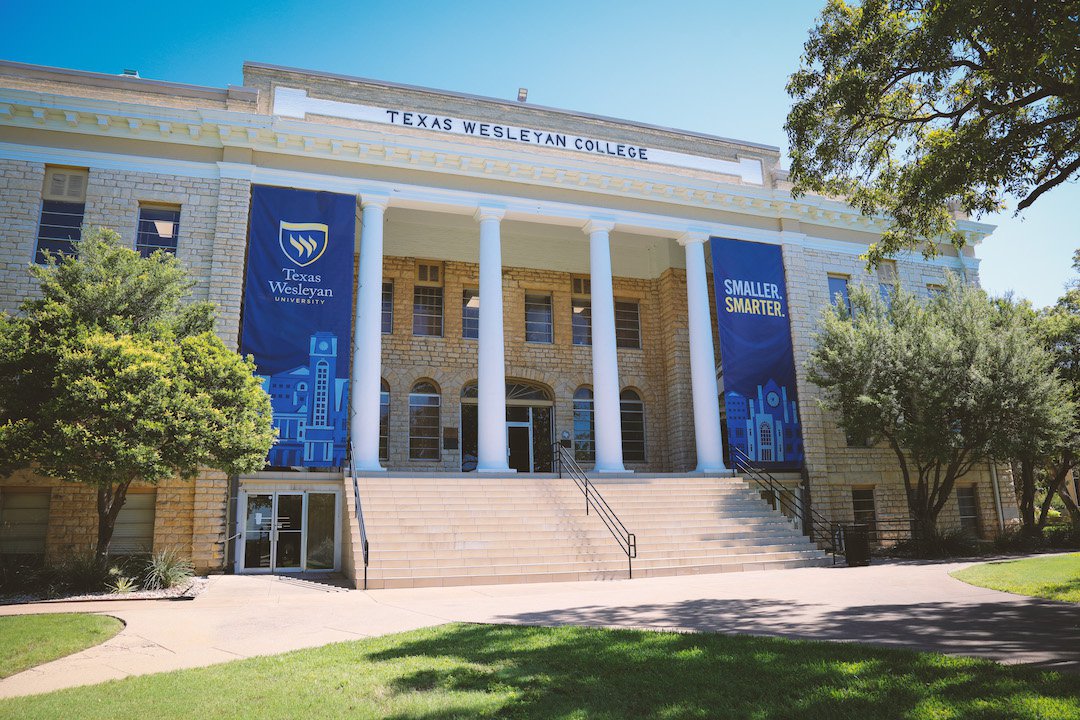The Victorian Texas Wesleyan Oneal-Sells Building was constructed in 1903 out of limestone quarried in Dublin — Texas, that is. In 1909, still under the leadership of President Bishop Hiram Abiff Boaz, it was remodeled and expanded into the historic landmark you know today.
If those walls could talk.
It was Boaz, from that very building, who envisioned a new landmark university for Methodism in the South. His plan was to develop Polytechnic College, founded in 1890, on Fort Worth’s East Side into just that school.
Then Dallas found out about it.
Maneuvering and intrigue followed. Among the rumored possibilities was Southwestern University moving north. The town fathers of Georgetown bared their teeth, snapped, and said, “Hands off, encroachers.”
Dallas leaders said no such thing was ever considered — well, that is, until they found out Fort Worth had an interest.
“The agitation of this question, understand, began with the proposition of Dr. Boaz of Polytechnic College to move Southwestern University to the city of Fort Worth,” officials of the Dallas Chamber of Commerce told The Dallas Morning News in August 1910. “This occasioned a public discussion of the matter in which Dallas took no part whatever and gave the question no serious consideration until so requested by the presiding elder of the Dallas district.
“Our whole action in the matter was predicated upon the fact that, in the event the university should be moved, Dallas stood ready to make a proposition to bring it to this city.”
Well, a battle of wills ensued between Fort Worth and Dallas over a new Methodist school to be built — or, in Fort Worth’s case, one to be added on to — in North Texas. Dallas won that bidding. Southern Methodist University, or SMU, was born — though not before, if only for a brief moment, considering “Texas Wesleyan” as its name.
The combatants emerged from the period in solidarity, agreeing to work together in support of Methodist university institutions, bound by the Wesleyan call to knowledge, faith, and service.
Polytechnic College moved on and evolved, with the Methodists’ assistance and blessing, becoming Texas Woman’s College in the immediate aftermath. In 1934, it was renamed Texas Wesleyan College (and later Texas Wesleyan University), marking a return to coeducational status.
Texas Wesleyan University is celebrating a milestone birthday throughout the 2025–26 academic calendar.
Fort Worth’s oldest higher education institution is turning 135 years old. And it is as strong today as it has ever been as a catalyst for progress for the city and the students it serves.
Leading the university into its next chapter is Dr. Emily Messer, the school’s 21st president and first female leader, appointed in 2023 and formally installed the next year.
“We are really inviting and encouraging our community, our city, and our stakeholders to celebrate with us,” Messer says. “We don’t want to do this siloed, just within the institution. We want it to be a celebration for the entire city of Fort Worth. We are the founding institution of higher education in the city.”
Founded the year before, Wesleyan opened its doors in 1891 with 111 students. It began the 2025 fall semester boasting a 10% increase in overall enrollment, with 2,792 total students — a continuation of recent growth.
The university also welcomed the largest first-year class in its history with 501 students, eclipsing the record set in 2023 with 490. Transfer and graduate enrollment also saw increases.
“This historic level of interest is a strong signal that students and families recognize the value of a Texas Wesleyan education,” Messer said. “We offer a personalized experience to remove barriers for students while ensuring they succeed in their selected field. Our university is focused on academic rigor, affordability, and transformative opportunities for all students. Texas Wesleyan students graduate prepared not only for their first job but for leadership and lifelong success.”
Moreover, school officials said a record number of first-year applications were received, growing 29% over the previous year.
At least some of the growth is attributable to the school’s TXWES Promise — a full-tuition program for Pell Grant-eligible Texas residents — said Lauren Findley, vice president of enrollment management.
“We are proud to open doors for all students, ensuring they thrive at Texas Wesleyan beyond enrollment,” Findley said.
With more than half of students identifying as first-generation college students, Wesleyan was recently named a First-Gen Forward campus, a national designation for leading universities supporting the needs of first-generation students.
In August, the school reported a $241 million total annual economic impact in North Texas — a 64% increase over the previous year. Ninety-five percent of its more than 27,000 living alumni live within 50 miles of campus.
U.S. News & World Report has recognized the university’s programs in nurse anesthesia, psychology/counseling, and business. The school has also developed certification programs in continuing education.
“The commitment of our faculty and staff has resulted in a growing reputation that our small-campus environment leads students toward greater opportunities for their futures,” said Findley.
The university is closing in on achieving a $40 million capital campaign and the construction of a long-awaited football stadium on the west side of campus — a project poised to bring renewed life to the East Rosedale corridor. The university is also collaborating with the city on revitalizing Polytechnic Heights through the Main Street Program.
It will be, Messer said, “another step forward in connecting our campus with the broader community and ensuring a vibrant future for the area.”
A new strategic plan for the coming decades is in the works, she added from her office in the Oneal-Sells Administration Building.
“It’s exciting to look at the future,” Messer said. “We’re working on so many things. We can’t share a whole lot right now, but once we launch our strategic plan, it’s going to be really exciting.”

